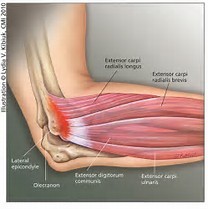Tennis elbow: Lateral Epicondyalgia
Are you suffering from lateral elbow pain?
Tennis elbow is a common musculoskeletal disorder of elbow and is usually an overuse injury. It is characterized by pain over the lateral elbow that is typically aggravated by gripping activities. Despite the name, tennis elbow, only 5% of all cases relate to tennis players. The syndrome is most prevalent (35-64% of cases) in jobs requiring repetitive wrist movements such as electricians, carpenters, gardener etc. It usually affects the dominant arm and is common between the ages of 35 and 50. Some of the common provoking activities are computer use, heavy lifting, repetitive vibration, forceful forearm pronation, and supination.
Tennis elbow is most commonly called lateral epicondylitis in medical term. However, numerous recent studies show the ab sence of inflammation in this disorder. Therefore, the terms, lateral epicondyalgia or epicondylar tendinopathy are more appropriate and are commonly used. Recent evidence suggests that the pain associated with tennis elbow is due to the impairments of the pain and motor systems as well as morphological changes in the structure of extensor carpi radialis brevis and common extensor tendon mechanism. In some cases, other extensor muscles, extensor carpi radialis longus, extensor digitorum and extensor carpi ulnaris are also involved.
sence of inflammation in this disorder. Therefore, the terms, lateral epicondyalgia or epicondylar tendinopathy are more appropriate and are commonly used. Recent evidence suggests that the pain associated with tennis elbow is due to the impairments of the pain and motor systems as well as morphological changes in the structure of extensor carpi radialis brevis and common extensor tendon mechanism. In some cases, other extensor muscles, extensor carpi radialis longus, extensor digitorum and extensor carpi ulnaris are also involved.
Why do you get this lateral elbow pain?
Tennis elbow got its name because tennis involves repeated gripping and twisting movements of the wrist, which typically overloads extensor muscles. This action is more provocative in the backhand stroke when wrist extensor muscles have to work extensively from wrist flexion. Thus, tennis elbow injuries mostly occur if repetitive micro-trauma involves forces that the muscle tissues are unable to cope with. Numerous studies have reported the signs of neurogenic involvement, neovascularization, and changes in muscle morphology or degeneration or fiber necrosis in injured muscle fibers or tendon retinaculum.
Common activities causing tennis elbow
- Sudden change or unaccustomed hand use. For example, painting a fence, hammering, excessive typing, change of firmness of bat or playing surfaces.
- Excessive and repetitive wrist extension activities especially with forearm pronation.

- Weak or tight forearm muscles.
- Excessive gripping, wringing or vibrating activities.
- Restricted range of motion of upper extremity joints. For example, restricted external rotation of the shoulder, restricted elbow and wrist flexion or extension.
- A poor technique of hitting a ball, lifting objects or typing etc.
Referred pain from neck can mimic tennis elbow
There is a high incidence of tennis elbow like lateral elbow pain with the involvement of C5, C6 spine. The cervical spine pathology or c5, c6 nerve root involvement can transmit pain signals along the radial nerve. Thus, the radial nerve injury or reduced neural mobility can cause symptoms similar to tennis elbow. So, this neck dysfunction is usually ruled out before diagnosing tennis elbow.
Clinical presentation:
- Pain on the lateral epicondyle. Palpation on the extensor muscles origin on lateral epicondyle produces or increases pain.
- Increased pain with provoking activities like resisted wrist extension, forearm pronation, wringing hand.

- Radiation of pain along upper arm, the lateral side of the forearm, in chronic cases to the third and fourth fingers.
- Reduced grip strength, especially with wrist extension.
- Reduced flexibility and strength of wrist extensors and posterior shoulder muscles.




I see your website needs some fresh content. Writing manually is time consuming, but there is solution for this hard task.
Just search for; Miftolo’s tools rewriter
I liked the post. Thanks for the information. keep posting.
thank you very much. Please keep writing and feedback.
really simple and precise information. enjoyed reading. ta
I enjoy the efforts you have put in this, regards for all the great articles.
Thank you all. Appreciate your feedback. Please, subscribe.
Great Blogpost Thanks for sharing.
Hmm it looks like your site ate my first comment (it was extremely long) so I guess I’ll just sum it up what I submitted and say, I’m thoroughly enjoying your blog. I too am an aspiring blog blogger but I’m still new to the whole thing. Do you have any points for first-time blog writers? I’d certainly appreciate it.
In this awesome pattern of things you actually get a B+ for effort. Where you misplaced us ended up being in your specifics. You know, they say, details make or break the argument.. And it couldn’t be much more true at this point. Having said that, let me inform you precisely what did deliver the results. The text is very convincing which is possibly the reason why I am taking the effort in order to comment. I do not make it a regular habit of doing that. 2nd, although I can certainly notice the leaps in reasoning you come up with, I am not convinced of how you appear to connect the points that help to make the actual final result. For right now I will, no doubt subscribe to your position however trust in the future you connect your dots better.
I for all time emailed this blog post page to all my associates, because
if like to read it after that my friends will too.
Your way of telling everything in this article is actually pleasant,
every one be able to effortlessly know it, Thanks a lot.
Appreciate this post. Will try it out.
Hello, the whole thing is going well here and ofcourse every one is sharing data, that’s really excellent, keep up writing.
Hi there, I would like to subscribe for this web site to get most up-to-date updates, thus where can i do it please help out.
You can subscribe by submitting your name and email address in subscribe box present at the right side of the page.
I’m extremely impressed with your writing skills and also with the layout on your blog. Is this a paid theme or did you modify it yourself? Anyway keep up the excellent quality writing, it’s rare to see a nice blog like this one today.
Thank you
I must express thanks to the writer just for rescuing me from this particular incident. Because of surfing around through the world-wide-web and finding notions which are not beneficial, I believed my life was well over. Living devoid of the strategies to the difficulties you’ve resolved by means of your entire website is a critical case, as well as the kind that would have in a negative way affected my career if I hadn’t discovered your site. The competence and kindness in taking care of every aspect was very useful. I’m not sure what I would’ve done if I had not encountered such a point like this. It’s possible to at this time relish my future. Thank you very much for this specialized and amazing help. I will not think twice to endorse your blog to anybody who desires tips about this area.